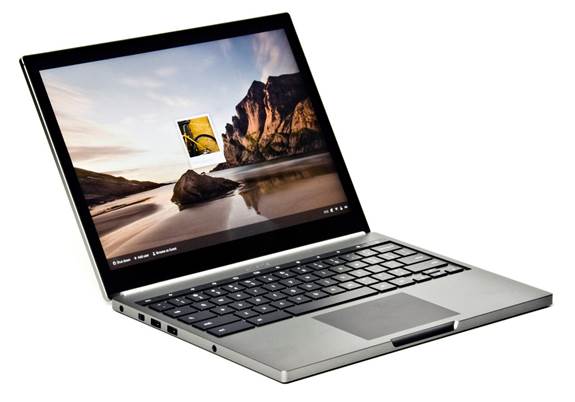It's the Tesla Model S of laptops after
almost three years, it’s still difficult to explain to Techno-Newbs just what
the hell Google's Chrome OS and Chromebooks are exactly.
Browser-only OS? No, when we tell people
that, we just get a slack-jawed look that tells us they don’t understand what
that even means. Instead, we’ve taken to using a car analogy to help explain
the concepts.

Google
Chromebook Pixel
A laptop with a full-service OS (whether
Windows, Linux, or even OSX) is a truck with a sports car engine; it gives you
mind-bending performance and cargo capability not available on any other
consumer hardware. An ARM-based device is more akin to early hybrid vehicles.
They give you amazing run time and portability, and the applications for what
they are work pretty damned well when scaled down for the platform.
If that analogy holds up, the Chrome-book
is an electric car. It's fine when you have Internet access, but once you’re
offline, its capabilities plummet. It’s like trying to drive your electric car
across the United States it's just not feasible at this point unless you want
to stop every 250 miles and park the car overnight near a power outlet.
Well, kids, behold the Tesla Model S of
personal computers: the Chromebook Pixel. Built on a stunning aluminum shell,
the Chromebook Pixel is the sexiest Chromebook we’ve ever seen and easily one
of the sexiest notebooks, too.

If
that analogy holds up, the Chrome-book is an electric car
It’s no clone/me-too notebook, either.
Google eschews the popular 16:9 aspect ratio screen for a 3:2 aspect-ratio IPS
multi-touch panel. This makes the screen slightly taller than 99 percent of the
notebooks out today. We appreciate the 3:2, but then again, we actually still
pine for the days of the long-ago 4:3 aspect-ratio screens, so maybe we’re just
crazy. The screen itself is an incredible 2560x1700 pixels crammed onto 12.8
inches diagonal. That gives it a PPI of 239, which is the highest in the
industry on a clamshell computing device. The etched glass and laser-honed
track pad is simply stunning to use, too.
The LTE version reviewed here features 64GB
of storage and gives you 100MB of data per month for two years. Pixel buyers
will also get 1TB of Google Drive storage for three years. The Wi-Fi-only model
cuts the storage in half and brings the price down to $1,300.
And proving that even for thin clients,
performance still matters, the Pixel uses a 1.8GHz Core i5 processor, which
makes a monkey out of all previous Chromebooks we’ve tested. On the graphics
side, some may beg to differ with the performance of the Intel HD 4000 graphics
[*cough* nVidia) but the combination outstrips any other Chrome OS notebook out
today. You’re probably wondering why you even need CPU performance for a
browser OS that actually runs decently on even limp ARM chips. Frankly, our gut
says Google has plans to use all the CPU horsepower in the Pixel on something.
Don’t believe us? Just Bing Google’s 10,000 Stars experiment on your old Atom-
or ARM-based Chromebook and you’ll see what we mean.

Still,
we understand what has led the majority of reviewers to label the Pixel the
sexiest notebook no one should ever buy - its utility still falls far short of
a full-service laptop
Still, we understand what has led the
majority of reviewers to label the Pixel the sexiest notebook no one should
ever buy - its utility still falls far short of a full-service laptop. At the
same time, there are a lot of a people who think the Tesla S is an impractical,
overpriced electric car, too. That assessment is probably accurate, but there’s
no denying that the Tesla S is a damned-sexy car few of us would turn down.
Same goes for the Google Pixel.
|
Google
Chromebook Pixel
·
Pros: Beautiful construction; pleasurable
track pad; 3:2 screen.
·
Cons: Chrome OS dependent on Internet; power
connector should be magnetic; expensive.
Specifications
·
CPU: Dual-core 1.8GHz Core i5
·
GPU: Intel HD4000
·
SunSpider JavaScript 0.9.1 (ms): 235
·
Google Octane V1: 12,906
·
FutureMark Peacekeeper: 3,773
·
Microsoft Fishbowl HTML 5: 60
|